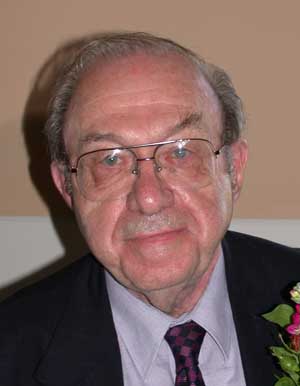Destruction Destroyed
Book Review
The Giant with Feet of Clay: Raul Hilberg and His “Standard Work” on the Holocaust by Jürgen Graf. Capshaw, Alabama: Theses and Dissertations Press, 2001. Paperback. 128 pages. Index, bibliography, illustrations.
In The Giant with Feet of Clay, the able and productive revisionist researcher and polemicist Jürgen Graf has undertaken to examine the standard scholarly treatment of the Holocaust, Professor Raul Hilberg’s Destruction of the European Jews, in exacting detail. Graf’s treatment of Giant is both less and more than a book review. He has chosen to concentrate on the essentials, those sections of Destruction which bear directly on the alleged mass killing, ignoring the great swathes of Hilberg’s elephantine work which describe the undisputed persecution of Jews throughout wartime Axis Europe. The result is a first-rate introduction to the substance and method of the revisionist challenge to the Holocaust, at no more than the size and length of pre-1993 editions of The Journal of Historical Review.
Even the case-hardened revisionist will be surprised to see how little of Destruction remains after the 1,231 pages of the three volume edition of 1985 are winnowed of all but those sections that deal with the evidence for a plan and an order to exterminate European Jewry, the actual mass killings, and the number of Jews said to have perished as a result of them. Graf is sharp on tracking Hilberg’s unexplained turnabout on the existence of the Hitler extermination order. He notes that Hilberg had claimed two successive Hitler orders in the original (1961) edition of Destruction, then points out that the historian has omitted all mention of any such order by Hitler in his “definitive” 1985 edition. Graf’s reminder of Hilberg’s 1983 statement that the Holocaust was not planned in advance, nor organized centrally by any agency, without blueprint or budget, but was instead achieved by “an incredible meeting of minds, a consensus-mind reading by a far-flung bureaucracy,” deftly torpedoes his target’s credibility here (as well as underlining the advisability of junking most of the flow charts and the rosters of bureaucrats and policemen with which Destruction abounds).
In the world of orthodox Holocaustry, Hilberg passes for a document and policy man, who more than once has expressed his distaste for the indulgence given the eyewitness testimony of “survivors” and other self-interested parties, such as the late propagandist Jan Karski. As Graf mercilessly exposes in his focus on the heart of the Holocaust claim, however, the professor is for all practical purposes entirely dependent on the testimony of survivors and the confessions of German captives in his efforts to substantiate the outlandish accusations made on what Hilberg calls “the killing centers.” Vrba, Wiesel, Nyiszli, Filip Müller, Gerstein, Höss, and more: every one of these key Hilberg witnesses to the gas chambers has had his credibility annihilated by the revisionists, and is increasingly doubted by exterminationists as well. In quick but deft analyses of the testimony of each of Hilberg’s eyewitness authorities for the gas chambers, Graf shows why.
Graf shines brightest in dispelling the murk that veils Auschwitz, Treblinka, and other supposed “killing centers.” Here the author, instead of devoting himself to the spatial studies (“gas chambers” and crematoria) preferred by other revisionists, has carefully studied the timeline alleged by Hilberg for the development of the extermination process (from gas vans to stationery chambers, from burial to open-air burning to cremation, etc.). Carefully correlating Hilberg’s sources, including Gerstein and Höss, Graf makes mincemeat of Hilberg’s widely accepted schema: instead of rational development there is contradiction, confusion, backtracking, and general absurdity. Nowhere, Graf shows, is the “incredible meeting of the minds” less credible in explaining the alleged “final solution” than in accounting for the origins and functioning of its key machinery.
Giant’s treatment of Hilberg’s accounts of the deportations, mass shootings, and estimated number of Jewish dead is spirited, though in view of the space and evidence, available, not as comprehensive. Each treatment, however, gives a more than adequate survey of how the state of recent knowledge renders Hilberg’s “standard treatment” not merely out of date, but dead wrong.
This is a translation, and an adequate one. Graf has worked from the 1997 German edition of Destruction, but mercifully his citations are in the English of Hilberg’s original, rather than rendered into a variant retroversion, as happens all too commonly. There are too many Briticisms, and too many Germanisms. The sarcasm and argumentativeness of The Giant do not always work well in translation.
The Giant with the Feet of Clay remains a very worthwhile book. According to the Arthur Butz, who took Hilberg’s measure a quarter century ago in his magisterial Hoax of the Twentieth Century: “This book has great educational value provided it is studied, rather than read.” That’s true: a clever sixteen year old who reads Giant will be able to crush Hilberg and flabbergast her instructor. (She’ll probably come away with an F, but that’s another matter.) Which isn’t to deter those readers who might look on Giant as a homework assignment: Jürgen Graf has written a lively, readable, up-to-date handbook to reveal that Raul Hilberg and his Holocaust, if not exactly giants, certainly have feet of clay.
Bibliographic information about this document: The Journal of Historical Review, vol. 20, no. 5+6 (September/December 2001), pp. 77f.
Other contributors to this document: n/a
Editor’s comments: n/a


